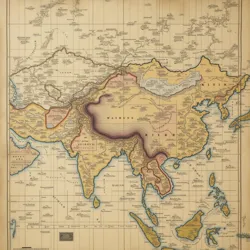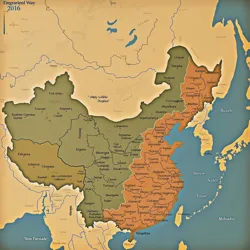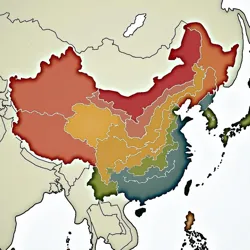Proto-Zhongyuan Language

Reconstructed ancestor of the Zhongyuan language family, foundational to understanding Jade Lands linguistic history.
Common Zhongyuan, Ancestral Zhongyuan
Zhongyuan
comparative method
Jade Lands
before 7th century CE
Liangningese, Yonganese, Jinghuanese
understanding linguistic history
Proto-Indo-European, Proto-Bantu
Proto-Zhongyuan (古中原祖語, Gǔ Zhōngyuán Zǔyǔ), also referred to as Common Zhongyuan or Ancestral Zhongyuan, is the reconstructed ancestor language of the Zhongyuan language family, a group of related languages spoken across the Jade Lands. This hypothetical language is not directly attested in written records but has been posited and meticulously reconstructed by historical linguists through the comparative method. By analyzing the systematic similarities and differences among the modern Zhongyuan languages – such as Liangningese language, Yonganese language, Jinghuanese language, and Shuhanese language – linguists have been able to infer the features of their shared linguistic progenitor.
The concept of Proto-Zhongyuan is crucial for understanding the linguistic and cultural history of the Jade Lands. It represents the linguistic bedrock from which the diverse languages of the region have sprung, mirroring in many ways the role of Proto-Indo-European in the study of European and Indo-Aryan languages, or Proto-Bantu in the study of languages across southern Africa. Studying Proto-Zhongyuan provides insights into the deep historical connections between the various states and cultures of the Jade Lands, revealing a shared linguistic heritage that predates the Era of Division and the subsequent centuries of political fragmentation. The reconstruction of Proto-Zhongyuan is an ongoing endeavor, constantly refined as new linguistic data emerges and comparative techniques evolve, offering an ever-clearer picture of the linguistic past of this vibrant region.
Historical Context and Reconstruction
The Era of Linguistic Unity
 Linguists using comparative methods to reconstruct Proto-Zhongyuan by analyzing modern Zhongyuan languages.
Linguists using comparative methods to reconstruct Proto-Zhongyuan by analyzing modern Zhongyuan languages.Before the Ten Kingdoms Era, which commenced in the 7th century CE following the weakening of the Tang Dynasty, it is believed that a greater degree of linguistic uniformity prevailed across the region now known as the Jade Lands. While regional variations and dialects likely existed, these would have been variations within a single, largely cohesive linguistic system – Proto-Zhongyuan. This period of relative linguistic unity likely corresponded to periods of centralized imperial authority, such as during the early Tang Dynasty and its predecessors, which facilitated communication and cultural exchange across vast territories.
The Tang Dynasty, in particular, played a significant role in fostering linguistic and cultural standardization. The imperial court promoted a standard literary language based on the dialect of the capital, Chang'an, which served as a model for administration, scholarship, and literary expression throughout the empire. This literary standard, while not entirely erasing regional vernaculars, exerted a homogenizing influence on the spoken languages of the elite and educated classes, contributing to the maintenance of a relatively unified linguistic landscape.
However, the seeds of linguistic divergence were already present even during periods of unity. Geographical distances, natural barriers, and pre-existing local linguistic substrata would have contributed to subtle variations in pronunciation, vocabulary, and grammar across different regions. These latent variations would become more pronounced as central imperial authority weakened and political fragmentation set in, ultimately leading to the emergence of the distinct languages of the Zhongyuan family.
The Comparative Method and Proto-Language Reconstruction
Proto-Zhongyuan, as an unattested language, can only be accessed through the methods of historical linguistics, primarily the comparative method. This method involves systematically comparing sets of related words (cognates) from daughter languages to reconstruct their ancestral forms in the proto-language. The underlying principle is that regular sound correspondences between related languages point to shared ancestry and can be used to reverse-engineer the sound system and vocabulary of the proto-language.
For example, if linguists observe that the sound l in Liangningese words consistently corresponds to n in Yonganese words and r in Jinghuanese words in similar semantic contexts, this regular correspondence suggests that these sounds are reflexes of a single sound in Proto-Zhongyuan. By analyzing numerous such correspondences across a wide range of vocabulary items and grammatical features, linguists can gradually build up a picture of the phonology, grammar, and lexicon of the proto-language.
The reconstruction of Proto-Zhongyuan is not a simple or mechanical process. It requires careful analysis of vast amounts of linguistic data, consideration of various sound changes and analogical processes, and a deep understanding of the historical and cultural contexts in which the daughter languages evolved. Linguists utilize various tools and techniques, including:
- Identifying Cognates: Determining which words in the daughter languages are descended from a common ancestor. This involves considering both phonetic similarity and semantic correspondence.
- Establishing Sound Correspondences: Identifying regular patterns of sound changes between cognates in different languages. These correspondences are the key to reconstructing proto-sounds.
- Reconstructing Proto-Sounds: Inferring the sounds of the proto-language based on the established sound correspondences. This often involves applying principles of linguistic typology and considering plausible sound changes.
- Reconstructing Proto-Grammar: Reconstructing grammatical features of the proto-language by comparing grammatical structures and morphemes in the daughter languages.
- Internal Reconstruction: Analyzing irregularities and inconsistencies within a single language to infer earlier stages of that language and contribute to proto-language reconstruction.
- Lexical Reconstruction: Reconstructing the vocabulary of the proto-language by identifying cognates and applying sound correspondences.
The reconstruction of Proto-Zhongyuan is an iterative and ongoing process. As linguistic research progresses and new data becomes available, reconstructions are constantly refined and updated. It is important to note that proto-languages are theoretical constructs, representing our best scholarly approximations of linguistic ancestors based on the available evidence. They are not meant to be perfect or complete replicas of the actual spoken languages of the past, but rather invaluable tools for understanding linguistic history and relationships.
Evidence for Proto-Zhongyuan
The primary evidence for the existence and characteristics of Proto-Zhongyuan comes from the observable similarities and systematic differences among its descendant languages. These languages, despite their current diversity, exhibit a wealth of shared features that point to a common origin. Key areas of evidence include:
- Cognate Vocabulary: The Zhongyuan languages share a significant amount of core vocabulary. Words for basic concepts, kinship terms, numerals, body parts, natural phenomena, and common actions are often recognably related across the family, exhibiting regular sound correspondences. For example, the word for "eye" in various Zhongyuan languages demonstrates a clear cognate set, allowing linguists to reconstruct a Proto-Zhongyuan form.
- Shared Grammatical Structures: The Zhongyuan languages exhibit similar grammatical structures, such as Subject-Verb-Object (SVO) word order, classifier systems, reliance on grammatical particles, and isolating morphology. These shared structural features suggest that they inherited them from a common ancestor with a similar grammatical profile.
- Regular Sound Correspondences: As mentioned earlier, systematic sound correspondences between the Zhongyuan languages provide compelling evidence for their shared origin. These correspondences are not random but follow predictable patterns, indicating that they are the result of regular sound changes operating on a common ancestral sound system. For instance, the consistent correspondence of certain initial consonants or vowel qualities across different languages strongly supports the reconstruction of specific Proto-Zhongyuan phonemes.
- Reconstructed Proto-Forms: Through the comparative method, linguists have reconstructed numerous Proto-Zhongyuan forms for words and grammatical morphemes. These reconstructed forms, while hypothetical, represent our best estimates of the linguistic features of the ancestral language. The coherence and systematicity of these reconstructions further strengthen the case for the existence of Proto-Zhongyuan as a real linguistic entity in the past.
- Geographical Distribution and Historical Context: The geographical distribution of the Zhongyuan languages within the Jade Lands, and the historical context of periods of unity followed by fragmentation, provide a plausible scenario for the divergence of a once-unified language into the current family of languages. The historical narrative of the Tang Dynasty's decline and the subsequent Era of Division aligns with the linguistic evidence of Proto-Zhongyuan divergence.
Characteristics of Proto-Zhongyuan
While Proto-Zhongyuan is a reconstructed language, linguistic analysis allows us to infer a number of its probable characteristics. These reconstructions are based on the features shared and contrasted among its daughter languages, offering a glimpse into the linguistic structure of this ancestral tongue.
Phonology of Proto-Zhongyuan
Reconstructing the phonology of Proto-Zhongyuan is a complex undertaking, but comparative evidence suggests the following features:
- Consonant Inventory: Proto-Zhongyuan likely possessed a rich consonant inventory, possibly including stops (like p, t, k, b, d, g), fricatives (like s, x, h), affricates (like ts, tʃ), nasals (like m, n, ŋ), and liquids (like l, r). It is debated whether Proto-Zhongyuan distinguished between voiced and voiceless stops, or aspirated and unaspirated stops, as these distinctions vary across the daughter languages. Some reconstructions propose a system with voiceless unaspirated, voiceless aspirated, and voiced stops, similar to some Tibeto-Burman languages.
- Vowel Inventory: The vowel system of Proto-Zhongyuan is also reconstructed as relatively complex, likely including a range of monophthongs and potentially some diphthongs. Reconstructions often posit a system with at least six to eight vowel qualities, including high, mid, and low vowels, and front, central, and back vowels. The exact number and phonetic qualities of these vowels are still subjects of scholarly debate and refinement.
- Syllable Structure: Proto-Zhongyuan likely had a relatively simple syllable structure, typically consisting of a consonant-vowel (CV) or consonant-vowel-consonant (CVC) pattern. Complex consonant clusters, such as those found in some modern Liangningese dialects, are generally considered to be later developments or influences from contact languages, rather than features of Proto-Zhongyuan itself.
- Tonal System (or Proto-Tones): A major question in Proto-Zhongyuan phonology is the presence or absence of tones. Modern Zhongyuan languages are tonal, but it is debated whether Proto-Zhongyuan was already tonal, or whether tones developed later in the daughter languages. Some theories propose that Proto-Zhongyuan may have had proto-tones, which were not fully lexicalized but represented distinctions in register or voice quality, which later evolved into full lexical tones in the descendant languages. Other theories suggest that tones arose independently in different branches of the Zhongyuan family.
Grammar of Proto-Zhongyuan
Reconstructing the grammar of Proto-Zhongyuan is also challenging, but comparative evidence allows for some inferences:
- Word Order: The most probable word order for Proto-Zhongyuan is Subject-Verb-Object (SVO), as this is the dominant word order in most modern Zhongyuan languages. While some minority theories propose SOV or other orders, SVO is generally considered the most parsimonious reconstruction based on the typological tendencies of related language families and the distribution of word order in the daughter languages.
- Morphology: Proto-Zhongyuan is reconstructed as having been primarily isolating in morphology, meaning that words were largely composed of single morphemes, and grammatical relations were indicated by word order and grammatical particles rather than inflectional affixes. Agglutination and inflection are not considered to have been significant features of Proto-Zhongyuan grammar, although some derivational morphology may have existed.
- Grammatical Categories: Proto-Zhongyuan likely possessed grammatical categories similar to those found in modern Zhongyuan languages, such as nouns, verbs, adjectives, pronouns, and grammatical particles. Nouns were likely not inflected for gender, number, or case. Verbs were likely not conjugated for person or number, but may have had aspectual and modal distinctions marked by particles or auxiliary verbs. Classifiers were possibly present in Proto-Zhongyuan, as they are a widespread feature in the Zhongyuan language family, though their precise system in the proto-language is debated.
- Syntax: Proto-Zhongyuan syntax likely relied heavily on word order and grammatical particles to express grammatical relations and sentence structure. Topic-comment structures, common in modern Zhongyuan languages, may have already been a feature of Proto-Zhongyuan syntax. Sentence-final particles, used to express grammatical mood and discourse functions, were also likely present in some form.
Vocabulary of Proto-Zhongyuan
Reconstructing the vocabulary of Proto-Zhongyuan involves identifying cognates across the daughter languages and inferring the semantic range of proto-words. Reconstructed Proto-Zhongyuan vocabulary provides insights into the culture and environment of the speakers of the proto-language. Some semantic fields that are relatively well-reconstructed include:
- Basic Kinship Terms: Words for "father," "mother," "sibling," "child," and other fundamental family relationships are often reconstructable, reflecting the importance of kinship in early Jade Lands societies.
- Numerals: The basic numerals (one, two, three, up to ten and beyond) are usually well-preserved and reconstructable, providing evidence for early counting systems.
- Body Parts: Words for major body parts (eye, ear, hand, foot, etc.) are generally cognate across the family, reflecting fundamental human experience.
- Natural Phenomena: Words for sun, moon, water, mountain, river, and other basic elements of the natural world are often reconstructable, indicating the environment in which Proto-Zhongyuan speakers lived.
- Agriculture and Early Technology: Reconstructed vocabulary related to agriculture (farming, crops, tools) and early technology (fire, cooking, basic crafts) can provide clues about the subsistence strategies and technological level of Proto-Zhongyuan speakers.
- Early Concordian Way Concepts: Some linguists and historians speculate about the possibility of reconstructing Proto-Zhongyuan terms related to early spiritual or philosophical concepts that may have been precursors to the Concordian Way. This is a more speculative area, but the shared spiritual heritage of the Jade Lands suggests the possibility of deep linguistic roots for some core Concordian concepts.
Divergence and Descendant Languages
The Zhongyuan Language Family
 Map showing the geographical distribution of the nine major languages descended from Proto-Zhongyuan across Jade Lands states.
Map showing the geographical distribution of the nine major languages descended from Proto-Zhongyuan across Jade Lands states.Proto-Zhongyuan is the ancestor of the Zhongyuan language family, which comprises the nine major languages currently spoken in the Jade Lands states, as well as various dialects and sub-varieties. The major languages are:
- Liangningese language (梁寧語, Liángníng Yǔ), spoken in Liang-Ning.
- Yonganese language (永安語, Yǒng'ān Yǔ), spoken in Yong-An.
- Jinghuanese language (京華語, Jīnghuá Yǔ), spoken in Jing-Hua.
- Shuhanese language (蜀漢語, Shǔhàn Yǔ), spoken in Shu-Han.
- Minyue (閩越語, Mǐnyuè Yǔ), spoken in Min-Yue.
- Wuyuese (吳越語, Wúyuè Yǔ), spoken in Wu-Yue.
- Yanzhao (燕趙語, Yānzhào Yǔ), spoken in Yan-Zhao.
- Qilu (齊魯語, Qílǔ Yǔ), spoken in Qi-Lu.
- Jinweiese (晉衛語, Jìnwèi Yǔ), spoken in Jin-Wei.
These languages, while distinct, share a demonstrable common ancestry in Proto-Zhongyuan. They exhibit varying degrees of mutual intelligibility, with languages geographically closer and historically more interconnected generally being more mutually comprehensible. Yonganese, often considered the prestige language and cultural center of the Jade Lands, is frequently cited as being relatively close to Proto-Zhongyuan in some respects, although all modern Zhongyuan languages have undergone significant evolution and divergence from their common ancestor.
Factors in Linguistic Divergence
The divergence of Proto-Zhongyuan into the modern Zhongyuan languages was a gradual process driven by a combination of factors:
- Geographical Separation: As populations migrated and settled in different regions of the Jade Lands, geographical distance and natural barriers hindered communication and interaction between communities. This geographical separation was a primary driver of linguistic differentiation, as dialects in isolated areas evolved independently.
- Political Fragmentation: The Era of Division and the subsequent Age of Contending States led to prolonged periods of political fragmentation across the Jade Lands. The establishment of independent states fostered distinct political and cultural identities, which in turn reinforced linguistic divergence. Each state developed its own administrative language, literary traditions, and cultural norms, further differentiating its language from those of neighboring states.
- Language Contact: Contact with other language families and languages spoken outside the Jade Lands also played a role in shaping the divergence of Proto-Zhongyuan. For example, Liangningese, spoken in the north, was influenced by languages of the northern steppes, while Jinghuanese, spoken in the coastal east, was influenced by maritime trade languages and cultures. These external influences contributed to the unique linguistic characteristics of each language.
- Internal Linguistic Change: Languages are constantly evolving, even in the absence of external factors. Processes of sound change, grammaticalization, lexical innovation, and analogy operate within each language community, leading to ongoing linguistic evolution and differentiation over time. These internal linguistic changes, accumulating over centuries, contributed significantly to the divergence of Proto-Zhongyuan into the modern languages.
- Social and Cultural Factors: Social and cultural factors, such as migration patterns, trade networks, religious movements, and literary traditions, also influenced linguistic divergence. The prestige of certain dialects, the development of distinct literary standards, and the formation of regional cultural identities all contributed to the shaping of the modern Zhongyuan languages.
Cultural and Historical Implications
Proto-Zhongyuan Society
 Exploring intersections between Proto-Zhongyuan language and ancestral Jade Lands culture, including society and beliefs.
Exploring intersections between Proto-Zhongyuan language and ancestral Jade Lands culture, including society and beliefs.While Proto-Zhongyuan is primarily a linguistic construct, its reconstruction offers potential insights into the society and culture of its speakers. Reconstructed vocabulary and grammatical features can provide clues about their way of life, social organization, and worldview. For instance, a rich reconstructed vocabulary related to agriculture might suggest that Proto-Zhongyuan speakers were settled agriculturalists. Reconstructed kinship terms can reveal aspects of their social structure and family organization. Even the grammatical structure of Proto-Zhongyuan, such as its word order and morphology, can reflect underlying cognitive patterns and cultural priorities.
Further research into the cultural context of Proto-Zhongyuan speakers is needed, and a new area of study, Proto-Jade Lands Culture (玉境先祖文化, Yùjìng Xiānzǔ Wénhuà), is emerging to explore these intersections between language and culture in the ancestral Jade Lands. This field aims to combine linguistic reconstruction with archaeological evidence, historical records (where available), and comparative cultural studies to paint a more comprehensive picture of the people who spoke Proto-Zhongyuan and their place in the early history of the Jade Lands. Proto-Jade Lands Culture would encompass aspects of social organization, subsistence strategies, material culture, early religious beliefs (possibly pre-Concordian Way), and interactions with neighboring groups.
Legacy and Influence on Jade Lands Culture
Despite the linguistic divergence that has occurred over centuries, the legacy of Proto-Zhongyuan continues to resonate throughout the Jade Lands. The shared linguistic heritage rooted in Proto-Zhongyuan is a fundamental element of the cultural unity that underlies the region's diversity. The Zhongyuan languages, despite their differences, share a common intellectual and literary vocabulary, facilitating communication and cultural exchange across state boundaries. The Concordian Way, the dominant spiritual tradition of the Jade Lands, has also been shaped by the linguistic and conceptual frameworks inherited from Proto-Zhongyuan and its speakers.
The study of Proto-Zhongyuan is not just an academic exercise in historical linguistics. It is a way to understand the deep historical connections between the peoples of the Jade Lands, to appreciate the shared roots of their diverse cultures, and to recognize the enduring linguistic and cultural legacy that binds them together despite political divisions. Ongoing research into Proto-Zhongyuan continues to refine our understanding of the linguistic past of the Jade Lands and its relevance to the present and future of this culturally rich and historically significant region.